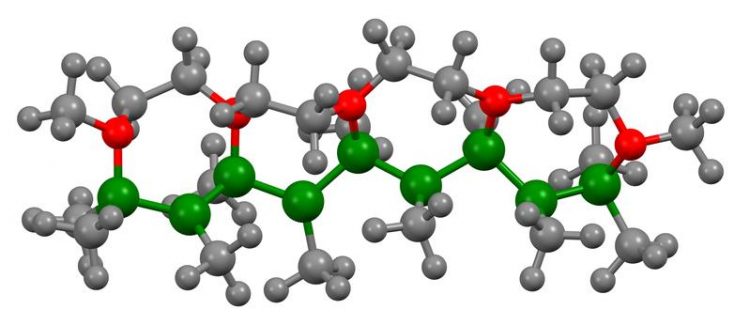Polymers Based on Boron?

How a potential boron polymer could look: boron atoms shown in green, oxygen atoms shown in red, carbon and hydrogen atoms shown in grey. Graphic: Dr. Rian Dewhurst
Plastic bags from polyethylene, packaging from polystyrene, frying pans with Teflon coatings: everyday life is awash with polymers. Chemically, polymers are long, chain-like molecules with backbones based almost exclusively on carbon (and sometimes silicon) atoms. Other types of polymers are rare.
The team of Chemistry Professor Holger Braunschweig at the Julius-Maximilians-Universität Würzburg (JMU) in Bavaria, Germany, have recently set their sights on the production of polymers based on chains of boron atoms. The as-yet-unknown boron polymers are expected to have highly unusual and useful properties – higher electrical conductance than polymers commonly used in the organic electronics industry being just one example.
Proposal to the DFG finds success
Holger Braunschweig's research proposal to the German Research Foundation (DFG) on this topic was successful: For this goal he will receive 1.5 million Euros from the DFG's Reinhart Koselleck program. This program was created to support particularly innovative and risky projects.
With this funding Prof. Braunschweig hopes to develop efficient synthetic strategies to boron polymers. In this respect it is critical to prevent the boron chains from collapsing in on themselves and forming clusters – a tendency that the element boron is famous for. The research team has come up with five promising strategies to form the desired chains. If successful, they will have discovered a fundamentally new class of materials, the potential applications of which could be immense.
Worldwide recognition as boron expert
The Reinhard Koselleck program of the DFG exclusively funds researchers with exceptional scientific track records. Holger Braunschweig is recognized as a worldwide expert in the chemistry of the element boron. His previous work includes a succession of fundamental breakthroughs in this field – including, among others, the synthesis of the first compound with a triple bond between two boron atoms.
For his work, Braunschweig has been distinguished with two ERC Advanced Grants, each coming with 2.5 million Euro of research funding. In 2009 he also received the 2.5 million Euro Leibniz Prize of the DFG.
Contact
Prof. Dr. Holger Braunschweig, Institute for Inorganic Chemistry / Institute for Sustainable Chemistry & Catalysis with Boron, JMU, Tel +49 931 31-85260, h.braunschweig@uni-wuerzburg.de
Media Contact
All latest news from the category: Life Sciences and Chemistry
Articles and reports from the Life Sciences and chemistry area deal with applied and basic research into modern biology, chemistry and human medicine.
Valuable information can be found on a range of life sciences fields including bacteriology, biochemistry, bionics, bioinformatics, biophysics, biotechnology, genetics, geobotany, human biology, marine biology, microbiology, molecular biology, cellular biology, zoology, bioinorganic chemistry, microchemistry and environmental chemistry.
Newest articles

A ‘language’ for ML models to predict nanopore properties
A large number of 2D materials like graphene can have nanopores – small holes formed by missing atoms through which foreign substances can pass. The properties of these nanopores dictate many…

Clinically validated, wearable ultrasound patch
… for continuous blood pressure monitoring. A team of researchers at the University of California San Diego has developed a new and improved wearable ultrasound patch for continuous and noninvasive…

A new puzzle piece for string theory research
Dr. Ksenia Fedosova from the Cluster of Excellence Mathematics Münster, along with an international research team, has proven a conjecture in string theory that physicists had proposed regarding certain equations….



